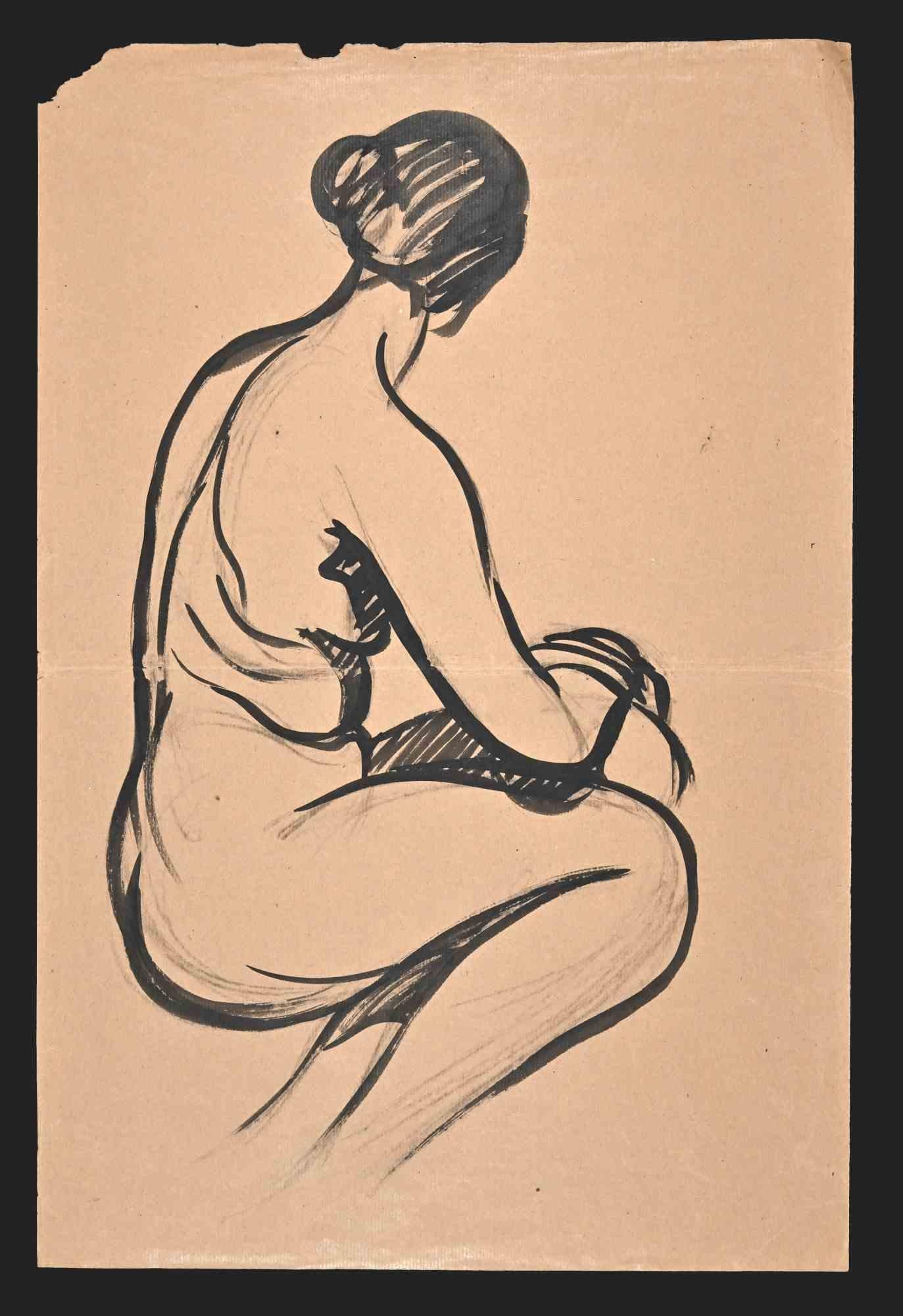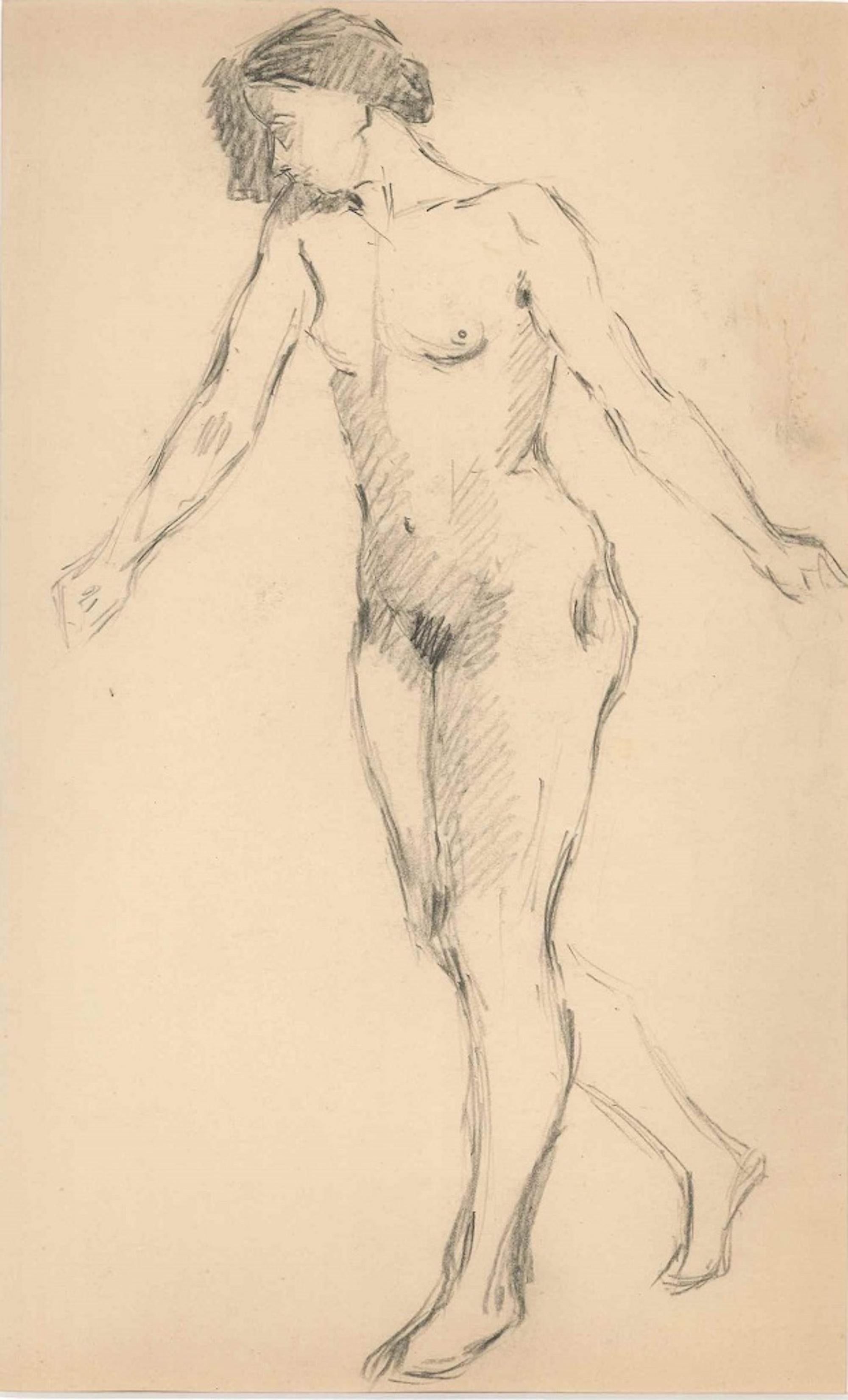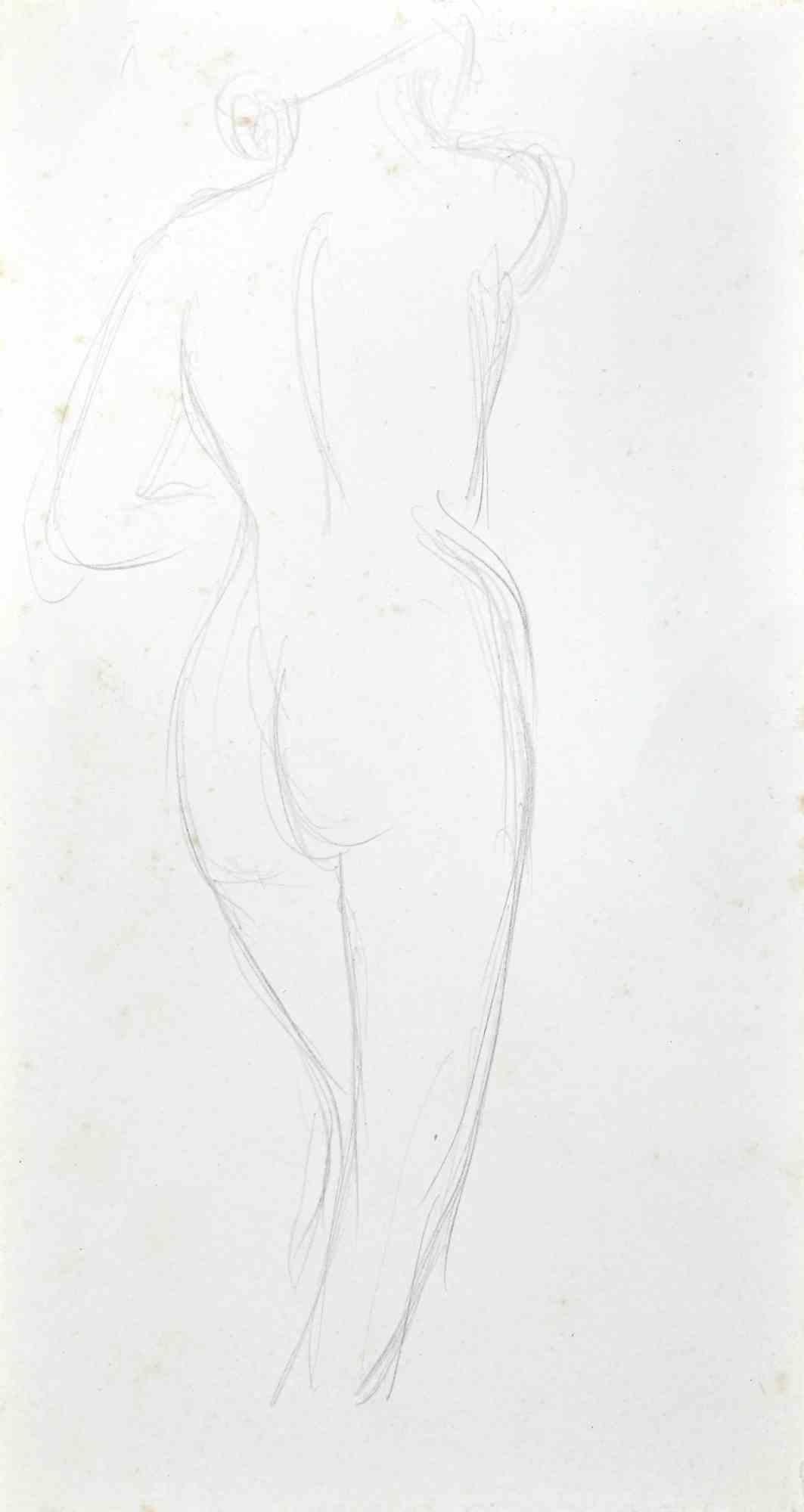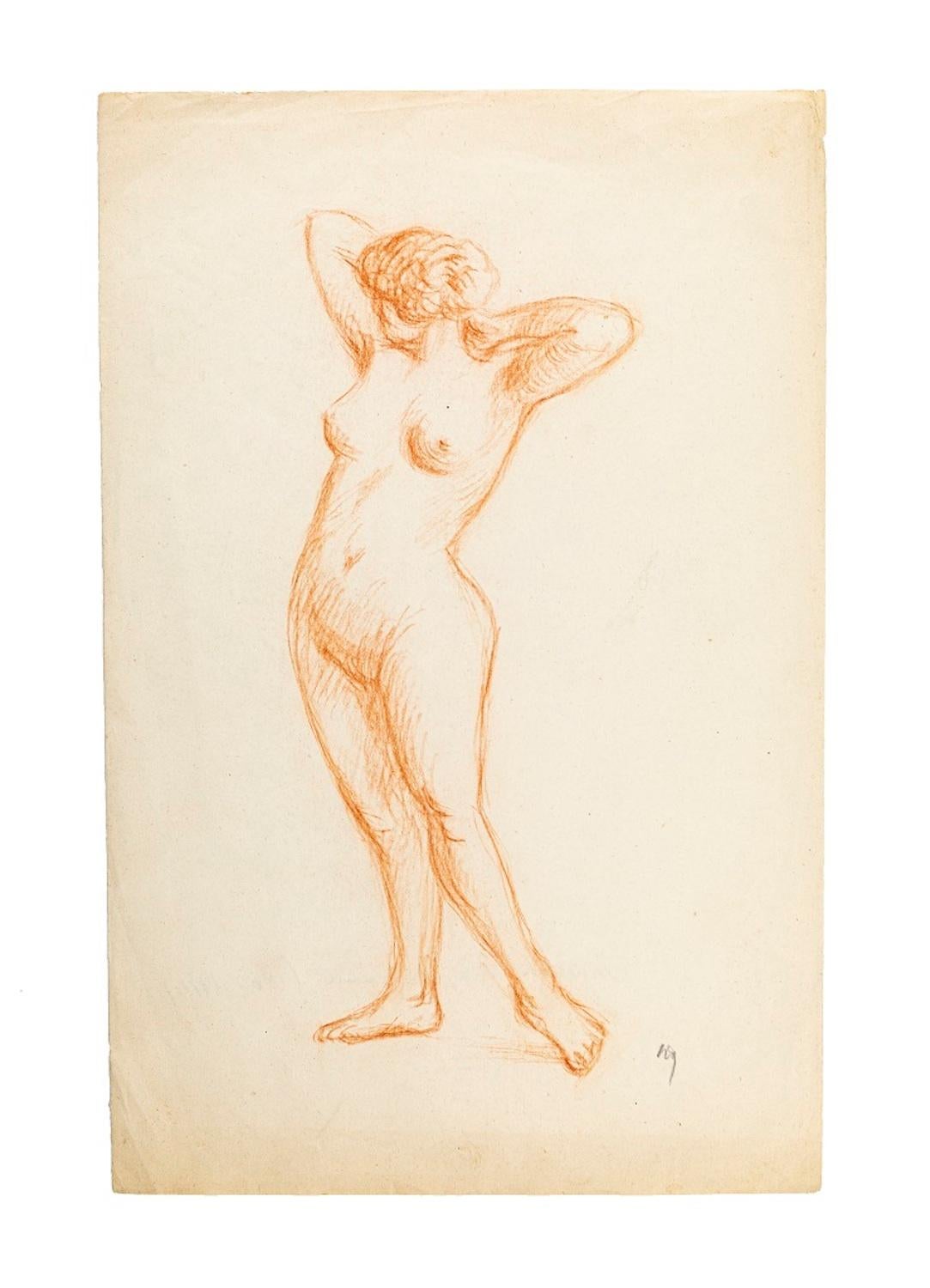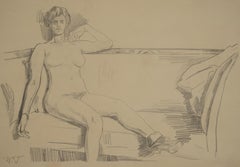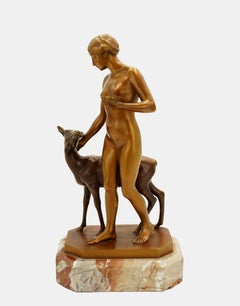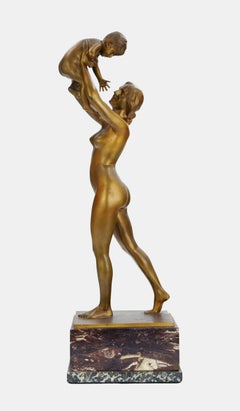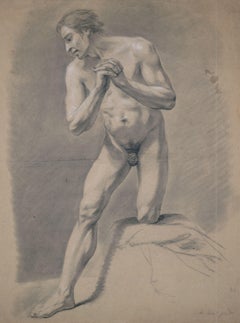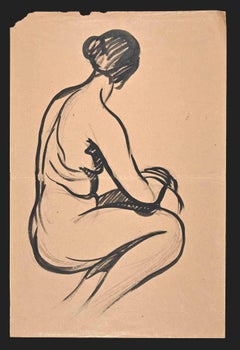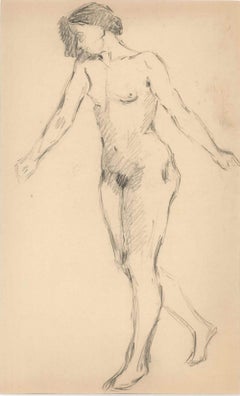Items Similar to Female Nude from the Back, around 1900 / - The contour of the Art Nouveau -
Want more images or videos?
Request additional images or videos from the seller
1 of 8
Ludwig von HofmannFemale Nude from the Back, around 1900 / - The contour of the Art Nouveau -c. 1900
c. 1900
$1,079.26
£802.86
€900
CA$1,477.88
A$1,643.20
CHF 857.99
MX$20,001.73
NOK 10,947.55
SEK 10,257.33
DKK 6,851.20
Shipping
Retrieving quote...The 1stDibs Promise:
Authenticity Guarantee,
Money-Back Guarantee,
24-Hour Cancellation
About the Item
Ludwig von Hofmann (1861 Darmstadt - 1945 Pillnitz), Female nude from the back, around 1900. Red chalk drawing on watermarked drawing paper, 36 cm x 44 cm (sheet size). Artist's ligature “LvH” in his own hand lower right.
- Margins more darkened, slight creases, minimally wavy.
- The contour of the Art Nouveau -
The female nude on the back is formed by a strongly curved Art Nouveau contour line, which allows the eye to glide along the body and makes the harmony of the female forms perceptible as ornamental movement. Hofmann creates the modulation of the inner body by blurring the red chalk as if it had been inhaled, so that the body, despite the strong contour, appears extremely delicate and exudes an aura of grace, while the expressive shadows cast further intensify the intensity of the effect emanating from the body. The head is posed in such a way that we cannot even guess at the profile. In this way, the figure is completely absorbed in the beauty of the living body.
"I was interested in the expressive, not the expressionistic. I feel humble towards nature, I don't want to rape it".
Ludwig von Hofmann
About the artist
Ludwig Hofmann studied at the Dresden Art Academy from 1883 to 1886 under Leonard Gey, Ferdinand Pauwels, Julius Scholtz, Friedrich Preller the Younger, and Léon Pohle, and was a master student of Ferdinand Keller at the Karlsruhe Art Academy from 1886 to 1888. Hofmann developed his own artistic ideas at an early age, which prompted Rainer Maria Rilke to have Hofmann illustrate his volume of poetry, "Lieder der Mädchen". In return, Rilke dedicated to Hofmann the cycle of poems "Die Bilder entlang", which was inspired by his works. The connection to literature is characteristic of Hofmann's oeuvre: Hugo von Hofmannthal, with whom Hofmann was friends, as well as Maurice Maeterlinck, Stefan George, and later especially Gerhard Hauptmann, wrote a foreword to the graphic portfolio "Tänze" (Dances), published in 1905. Hofmann later also worked as an illustrator, together with the book artist Marcus Behmer. For example, for Leopold Ziegler's translation of The Odyssey or Gerhart Hauptmann's Shepherd's Song.
In 1889, Hofmann was a student at the Académie Julian in Paris and was inspired by the works of Pierre Puvis de Chavannes and Paul-Albert Besnard. From 1890 Hofmann worked as a freelance artist in Berlin and was a member of the "Gruppe der Eleven" around Max Liebermann and Max Klinger, which later became the Secession. Hofmann designed the invitation card for the first exhibition of Künstlergruppe XI, the posters for the Free Berlin Art Exhibition in 1893, and the German Art Exhibition of the Berlin Secession in 1899. Hofmann also contributed works to the Secession exhibitions in Munich and Vienna. Since the founding of the Jugendstil magazine "Pan" in 1895, he regularly provided graphic contributions, as well as for "Jugend" and "Ver Sacrum".
Between 1894 and 1900, Hofmann spent a lot of time in Rome and at his villa near Fiesole, where he came to appreciate the painting of Hans von Marée, whose idea of a timeless, ancient Arcadia was to influence Hofmann's own work.
In 1903, Hofmann was appointed to the Grand Ducal Art School in Weimar, which was important for his artistic career. In 1905/06 Hofmann painted a six-part mural cycle for Henry van der Velde's museum hall at the Third German Arts and Crafts Exhibition in Dresden, and in 1907/08 the monumental frieze for the foyer of the Weimar Theater. In 1909 he created the monumental painting "Nine Muses" for the Senate Hall of the University of Weimar. In 1919 he designed the reading room of the German Library in Leipzig.
In Weimar, Hofmann was part of the "New Weimar" movement initiated by Harry Graf Kessler, which opposed Berlin's repressive art policies and would eventually become the Bauhaus. Through Kessler's international contacts, Hofmann became acquainted with Maurice Denis, Aristide Maillol, and Theo van Rysselberghe, who were pursuing related pictorial ideas. Among Hofmann's students in Weimar were Hans Arp and his son Gerhard Hauptmann Ivo. Hofmann had a long-standing friendship with Gerhart Hauptmann, which was accompanied by an intensive artistic exchange. In 1907 they traveled together to Greece, which Hofmann later described as the most important inspiration for his artistic development, along with the work of the painter Hans von Marées. In 1916 Hofmann succeeded Hermann Prell at the Dresden Art Academy, where he taught monumental painting until 1931.
In 1937, some of Hofmann's works were classified as "degenerate art" in Erfurt, but others continued to be exhibited in Germany. Hofmann died in Pillnitz in 1945. Ludwig von Hofmann's main estate is located in Potsdam, where the Ludwig von Hofmann Society is based.
Hofmann was honored with numerous awards: In 1896 he received the Gold Medal of the International Art Exhibition in Berlin, in 1897 the Gold Medal of the International Art Exhibition in Dresden, in 1906 the Certificate of Honor of the 3rd German Arts and Crafts Exhibition in Dresden, in 1908 the Knight's Cross of the 2nd Class of the Order of the White Falcon of Saxony-Weimar, In 1918 he was appointed Privy Councillor, in 1926 he received an honorary doctorate from the Faculty of Philosophy in Giessen, and in 1941 Hofmann was awarded the Goethe Medal for Art and Science.
Among the collectors of his works were the Austro-Hungarian Empress Elisabeth and the art historians Heinrich Wölfflin and Wilhelm von Bode. Thomas Mann incorporated impressions of Hofmann's work into his novel The Magic Mountain. The painting "Die Quelle", which he acquired in 1914, hung in Thomas Mann's study until his death.
In 2005, Ludwig von Hofmann, who was only gradually rediscovered, was the subject of a major monographic exhibition in his hometown of Darmstadt.
"Hofmann's work is characterized by his search for a neo-idealistic, neo-classical style that combines tradition and modernity, as well as his interest in the rhythmically moving figure.
Annette Wagner-Wilke
GERMAN VERSION
Ludwig von Hofmann (1861 Darmstadt - 1945 Pillnitz), Weiblicher Rückenakt, um 1900. Rötelzeichnung auf mit Wasserzeichen markiertem Zeichenpapier, 36 cm x 44 cm (Blattgröße). Unten rechts eigenhändig mit der Künstlerligatur „LvH“ versehen.
- Randbereiche stärker nachgedunkelt, leichte Knickspuren, minimal gewellt.
- Die Kontur des Jugendstils -
Der weibliche Rückenakt wird durch eine ausgeprägte geschwungene Jugendstil-Konturlinie geformt, die den Blick am Körper entlanggleiten lässt und die Harmonie der weiblichen Formen als ornamentale Bewegung erfahrbar macht. Die Binnenkörpermodulation erzeugt Hofmann durch wie hingehaucht wirkendes Verwischen der roten Kreide, so dass der Körper – trotz der starken Kontur – äußerst zart erscheint und eine Aura der Anmut verströmt, wobei der expressive Schattenwurf die vom Körper ausgehende Wirkintensität noch verstärkt. Die Kopfhaltung ist gerade so gewählt, dass wir das Profil nicht einmal erahnen können. Auf diese Weise geht die Figur ganz in der Schönheit des lebendig wirkenden Körpers auf.
"Das Expressive hat mich interessiert, nicht das Expressionistische. Ich fühle mich der Natur gegenüber demütig, will sie nicht vergewaltigen."
Ludwig von Hofmann
zum Künstler
Ludwig Hofmann studierte von 1883 bis 1886 an der Kunstakademie Dresden bei Leonard Gey, Ferdinand Pauwels, Julius Scholtz, Friedrich Preller d. J. und Léon Pohle und war von 1886 bis 1888 Meisterschüler von Ferdinand Keller an Kunstakademie Karlsruhe. Früh entwickelte Hofmann eigenständige künstlerische Ideen, die Rainer Maria Rilke dazu bewegten, seinen Gedichtband „Lieder der Mädchen“ von Hofmann illustrieren zu lassen. Im Gegenzug widmete Rilke Hofmann den an seinen Werken inspirierten Gedichtzyklus „Die Bilder entlang“. Die Verbindung zur Literatur ist für Hofmanns Oeuvre kennzeichnend: Zur 1905 erschienen Grafikmappe „Tänze“ verfasste Hugo von Hofmannthal ein Vorwort, mit dem Hofmann ebenso wie mit Maurice Maeterlinck, Stefan George und später insbesondere mit Gerhard Hauptmann befreundet war. Und auch später betätigte sich Hofmann, zusammen mit dem Buchkünstler Marcus Behmer, als Illustrator. So beispielsweise für die Odyssee-Übersetzung Leopold Zieglers oder das Hirtenlied von Gerhart Hauptmann.
1889 hielt Hofmann sich als Student an der Académie Julian in Paris auf und wurde durch die Werke von Pierre Puvis de Chavannes und Paul-Albert Besnard angeregt. Ab 1890 war Hofmann dann als freischaffender Künstler in Berlin ansässig und Mitglied der später in der Secession aufgehenden „Gruppe der Elf“ um Max Liebermann und Max Klinger. Für die erste Ausstellung der Künstlergruppe XI gestaltete Hofmann die Einladungskarte, für die Freie Berliner Kunstausstellung 1893 und die Deutsche Kunstausstellung der Berliner Secession 1899 die Plakate. Auch auf den Ausstellungen der Sezessionen in Münchner und Wien war Hofmann mit Werken beteiligt. Seit der Gründung der Zeitschrift des Jugendstils "Pan", 1895, lieferte er, ebenso wie für die "Jugend" und "Ver Sacrum", regelmäßig graphische Beiträge.
Von 1894 bis 1900 hielt sich Hofmann häufig in Rom und in seiner Villa bei Fiesole auf und lernt die Malerei Hans von Marées schätzen, dessen Vorstellung eines überzeitlichen antiken Arkadiens auch für Hofmanns Werk maßgeblich werden sollte.
1903 erhielt Hofmann den für seinen künstlerischen Werdegang wichtigen Ruf an die Großherzogliche Kunstschule in Weimar. 1905/06 malte Hofmann für Henry van der Veldes Museumshalle auf der Dritten deutschen Kunstgewerbeausstellung in Dresden einen sechsteiligen Wandbildzyklus und 1907/08 den Monumentalfries für das Foyer des Weimarer Theaters. 1909 entstand das Monumentalbild "Neun Musen" für den Senatssaal der Universität Weimar. 1919 folgte die Ausgestaltung des Lesesaals der Deutschen Bücherei in Leipzig.
In Weimar gehörte Hofmann zu der von Harry Graf Kessler initiierten, gegen die repressive Berliner Kunstpolitik gerichtete Bewegung „Neues Weimar“, aus der schließlich das Bauhaus hervorgehen sollte. Durch die internationalen Kontakte Kesslers wurde Hofmann mit Maurice Denis, Aristide Maillol und Theo van Rysselberghe bekannt, die verwandte Bildideen verfolgten. Zu Hofmanns Schülern in Weimar zählten Hans Arp und der Sohn Gerhard Hauptmann Ivo. Mit Gerhart Hauptmann verband Hofmann eine langjährige Freundschaft, die mit einem intensiven künstlerischen Austausch einherging. 1907 unternahmen sie eine gemeinsame Griechenlandreise, die Hofmann später - neben dem Werk des Malers Hans von Marées - als wichtigste Inspiration für seine künstlerische Entwicklung bezeichnet hat. 1916 trat Hofmann an der Kunstakademie Dresden die Nachfolge Hermann Prells an und unterrichtete bis 1931 das Fach Monumentalmalerei.
1937 wurden einige Werke Hofmanns in Erfurt als „Entartete Kunst“ eingestuft, andere aber weiterhin in Deutschland ausgestellt. 1945 starb Hofmann in Pillnitz. Der Hauptnachlass Ludwig von Hofmanns befindet sich in Potsdam, wo auch die Ludwig-von-Hofmann-Gesellschaft ihren Sitz hat.
Hofmann wurde mit zahlreichen Preisen geehrt: 1896 erhielt er die Gold-Medaille der Internationalen Kunstausstellung in Berlin, 1897 die Gold-Medaille der Internationalen Kunstausstellung Dresden, 1906 die Ehrenurkunde der 3. Deutschen Kunstgewerbeausstellung Dresden, 1908 das Ritterkreuz II. Klasse des Sachen-Weimerischen Weißen-Falken-Ordens, 1917 den Verdienstkranz für Kriegshilfe, 1918 wird er zum Geheimen Hofrat ernannt, 1926 erfolgt die Ehrenpromotion der Philosophischen Fakultät Gießen und 1941 erhält Hofmann die Goethe-Medaille für Kunst und Wissenschaft.
Zu den Sammlern seiner Werke zählten die österreich-ungarische Kaiserin Elisabeth ebenso wie die Kunsthistoriker Heinrich Wölfflin und Wilhelm von Bode. Thomas Mann ließ Eindrücke von Hofmanns Werk in seinen Roman „Der Zauberberg“ einfließen. Das von ihm 1914 erworbene Bild "Die Quelle" hing bis zu seinem Tod in Thomas Manns Arbeitszimmer.
2005 wurde dem erst allmählich wiederentdeckten Ludwig von Hofmann in seiner Geburtsstadt Darmstadt eine große monografische Ausstellung gewidmet.
"Hofmanns Schaffen ist geprägt von der Suche nach einem Tradition und Moderne vereinenden neuidealistischen, neuklassischen Stil sowie seinem Interesse an der rhythmische bewegten Figur.“
Annette Wagner-Wilke
- Creator:Ludwig von Hofmann (1861-1945, German)
- Creation Year:c. 1900
- Dimensions:Height: 14.18 in (36 cm)Width: 17.33 in (44 cm)Depth: 0.4 in (1 cm)
- Medium:
- Movement & Style:
- Period:
- Condition:
- Gallery Location:Berlin, DE
- Reference Number:1stDibs: LU2438215748432

About the Seller
5.0
Gold Seller
Premium sellers maintaining a 4.3+ rating and 24-hour response times
Established in 2014
1stDibs seller since 2023
20 sales on 1stDibs
- ShippingRetrieving quote...Shipping from: Berlin, Germany
- Return Policy
Authenticity Guarantee
In the unlikely event there’s an issue with an item’s authenticity, contact us within 1 year for a full refund. DetailsMoney-Back Guarantee
If your item is not as described, is damaged in transit, or does not arrive, contact us within 7 days for a full refund. Details24-Hour Cancellation
You have a 24-hour grace period in which to reconsider your purchase, with no questions asked.Vetted Professional Sellers
Our world-class sellers must adhere to strict standards for service and quality, maintaining the integrity of our listings.Price-Match Guarantee
If you find that a seller listed the same item for a lower price elsewhere, we’ll match it.Trusted Global Delivery
Our best-in-class carrier network provides specialized shipping options worldwide, including custom delivery.More From This Seller
View AllFemale Nude Sitting on a Sofa
Located in Berlin, DE
Wilhelm Trübner (1851 Heidelberg - 1917 Karlsruhe), Female Nude Sitting on a Sofa, around 1900. Pencil drawing, 32.5 x 48.5 cm, monogrammed “W.T.” lower left and inscribed on the rev...
Category
Early 1900s Realist Nude Drawings and Watercolors
Materials
Paper
Forest idyll / - Soulmate -
By Rudolf Kaesbach
Located in Berlin, DE
Rudolf Kaesbach (1873 Gladbach - 1955 Berlin), Forest idyll, around 1915. Bronze, gold and golden brown patina, with cast plinth, mounted on a marble base (5 cm high), total height 36 cm, dimensions of the bronze: 31 cm (height) x 17 cm (length) x 12 cm (width). Weight 4,6 kg, signed on the plinth "R.[udolf] KAESBACH".
- a few rubbed areas, overall in excellent condition for its age
- Soulmate -
The bronze sculpture depicts a young woman in an intimate exchange with a deer that accompanies her. The animal pauses to turn toward her, while the nude beauty slows her pace to look into the deer's eyes and tenderly caress it with her hand. The woman and the deer are in inner harmony. Even though her lips remain motionless, she speaks the language of the animal with which she is deeply connected.
The golden patina, which contrasts with the more naturalistic coloring of the deer, gives the young woman the appearance of a saint, even if she cannot be identified as such. At the same time, she evokes memories of Diana, the goddess of the hunt, or a nymph. But she lacks the ferocity. In her innocent naivety, she is more like a vestal virgin, who is not at home in the solitude of the forest. And yet, the young beauty, moving unclothed in the heart of nature, looks like a priestess with her hair tied up and a carefully carried bowl on her way to a sacred grove.
In order to open up the above-mentioned associations, Kaesbach deliberately designed the female figure in such a way that she cannot be identified as a specific person. He has created an allegory of natural femininity, characteristic of Art Nouveau, in which the deer is far more than a companion animal. It displays the same gracefulness as the young woman, and the inner resemblance between the two makes the deer appear as her other self. In animal terms, it embodies her inner being, which also gives the deer an allegorical character.
About the artist
Rudolf Kaesbach studied sculpture at the Hanau Academy and worked in a bronze foundry in Paris in 1900. In order to work as an independent artist, he opened a workshop in Düsseldorf, where he cast bronzes from models he designed. In 1902 he made his debut at the German National Art Exhibition in Düsseldorf. The following year Kaesbach went to the academy in Brussels. There he was inspired by contemporary Belgian sculpture, especially the work of Constantin Meunier. He moved to Berlin, where he opened a studio in the villa district of Grunewald and devoted himself to life-size marble sculptures and the design of bronzes. From 1911, he regularly presented his works at the major art exhibitions in Berlin, as well as in Düsseldorf and Malmö. Between 1936 and 1939, he also created models for the Rosenthal porcelain factory. From 1939 to 1944, Kaesbach was represented at the major German art exhibitions in Munich.
GERMAN VERSION
Rudolf Kaesbach (1873 Gladbach - 1955 Berlin), Waldidyll, um 1915. Gold und goldbraun patinierte Bronze mit gegossener Plinthe, auf einem Marmorsockel montiert (5 cm Höhe), Gesamthöhe 36 cm, Maße der Bronze: 31 cm (Höhe) x 17 cm (Länge) x 12 cm (Breite). Gewicht 4,6 kg, auf der Plinthe mit „R.[udolf] KAESBACH“ signiert.
- vereinzele beriebene Stellen, insgesamt in einem altersgemäß ausgezeichneten Zustand
- Seelenverwandtschaft -
Die Bronzeplastik veranschaulicht eine junge Frau im innigen Austausch mit einem sie begleitenden Reh. Das Tier hält inne, um sich zu ihr hochzuwenden, während die nackte Schönheit ihren Schritt verlangsamt, um dem Reh ebenfalls in die Augen zu schauen und es zärtlich mit der Hand zu liebkosen. Die Frau und das Reh sind in einem inneren Gleichklang. Auch wenn ihre Lippen unbewegt bleiben, spricht sie die Sprache des Tieres, mit dem sie auf eine tief empfundene Weise verbunden ist.
Die im Kontrast zur naturalistischeren Einfärbung des Rehs aufstrahlende goldfarbene Patina lässt die junge Frau wie eine Heilige erscheinen, auch wenn sich nicht als Heilige identifizierbar ist. Zugleich ruft sie Erinnerungen an die Jagdgöttin Diana oder eine Nymphe hervor. Dafür fehlt ihr allerdings die Wildheit. In ihrer unschuldigen Naivität gemahnt sie vielmehr an eine Vestalin, die freilich nicht in der Waldeinsamkeit zu Hause ist. Und doch wirkt die sich unbekleidet im Herzen der Natur bewegende junge Schönheit wie eine Priesterin, die sich mit hochgebundenem Haar und der vorsichtig getragenen Schale und dem Wege zu einem Heiligen Hain befindet.
Um die gennannten Assoziationen zu eröffnen, hat Kaesbach die Frauenfigur bewusst so gestaltet, dass sie nicht als konkrete Person identifizierbar ist. Damit hat er eine für den Jugendstil charakteristische Allegorie natürlicher Weiblichkeit geschaffen, bei der das Reh weit mehr als ein Begleittier ist. Es weist dieselbe grazile Anmut wie die junge Frau auf und der innere Gleichklag der beiden lässt das Reh als ihr anderen Ich erscheinen. Es verkörpert – ins Animalische übertragen - ihr inneres Wesen, wodurch auch dem Reh ein allegorischer Charakter zukommt.
zum Künstler
Rudolf Kaesbach studierte an der Akademie Hanau Bildhauerei und war im Jahr 1900 in einer Pariser Bronzegießerei tätig. Um sich als eigenständiger Künstler betätigen zu können, eröffnete er in Düsseldorf eine Werkstatt, in der er Bronzen nach selbstentworfenen Modellen goss. 1902 debütierte er auf der Deutschen Nationalen Kunstaustellung in Düsseldorf. Im Folgejahr ging Kaesbach an die Akademie nach Brüssel. Dort wurde er von der zeitgenössischen belgischen Bildhauerei, insbesondere vom Werk Constantin Meuniers, inspiriert. Zurückgekehrt zog er nach Berlin, wo er im Villenviertel Grunewald ein Atelier eröffnete und sich neben dem Entwurf für Bronzen der lebensgroßen Marmorbildhauerei widmete. Ab 1911 präsentierte er seine Werke regelmäßig auf den Großen Berliner Kunstausstellungen, aber auch in Düsseldorf und Malmö. Zwischen 1936 und 1939 fertigte er zudem Modelle für die Porzellan-Manufaktur Rosenthal an. Von 1939 bis 1944 war...
Category
1910s Jugendstil Nude Sculptures
Materials
Bronze
$4,029 Sale Price
20% Off
Mother Happiness / - The ecstasy of maternal joy -
Located in Berlin, DE
Johannes Boese (1856 Ostrog - 1917 Berlin), Mutterglück, um 1910. Goldbraun patinierte Bronze auf gegossener rechteckiger Plinthe, montiert auf zweifarbigem Marmorsockel (9,5 cm Höhe...
Category
1910s Art Nouveau Nude Sculptures
Materials
Bronze
$4,029 Sale Price
20% Off
Male Nude / - The Drama of the Nude -
Located in Berlin, DE
Johann Heinrich Meil (1730 Gotha - 1820 Berlin), Male Nude, 1807. White heightened, occasionally wiped charcoal drawing on brownish paper, 51 cm x 39.5 cm, signed “J.[ohann] H.[einri...
Category
Early 19th Century Rococo Nude Drawings and Watercolors
Materials
Paper
Study with Torso, Hands, and Umbrella - The characteristic of the inconspicuous
Located in Berlin, DE
Paul Friedrich Meyerheim (1842 Berlin - 1915 ibid.). Sketch of a female torso with hands and an umbrella. Pencil on paper, 27.5 x 22.5 cm (visible size)...
Category
1890s Realist Figurative Drawings and Watercolors
Materials
Pencil
The Feeding / - Natural grace -
Located in Berlin, DE
Erich Schmidt-Kestner (1877 Berlin - 1941 Nordhausen), The Feeding, around 1915. Gold and black patinated bronze with cast brown patinated plinth mounted on a lightly veined black-gr...
Category
1910s Art Nouveau Nude Sculptures
Materials
Bronze
$4,317 Sale Price
20% Off
You May Also Like
Nude From The Back - Drawing by Jean Delpech - Mid 20th century
By Jean Delpech
Located in Roma, IT
Reclined Nude is a drawing in watercolor realized in the Mid-20th Century by Jean Delpech (1916-1988).
Good conditions except for folding and a minor missing piece of paper at the ...
Category
Mid-20th Century Modern Figurative Drawings and Watercolors
Materials
Paper, Watercolor
Female Nude Figure in Profile - Original Drawing - Early 20th Century
Located in Roma, IT
Female Nude Figure is an original artwork realized by an Anonymous French artist in the first years of the 20th Century. Cardboard passepartout included (cm 49 x 34). Very good condi...
Category
Early 20th Century Modern Nude Drawings and Watercolors
Materials
Paper, Pencil
Standing Female Nude - Charcoal Drawing by M. Roche - Early 1900
By Marcel Roche
Located in Roma, IT
Standing Female Nude is a superb original drawing on paper, realized by the French artist Marcel Roche (1890-1959).
A beautiful and sensual standing woman is portrayed with a sanguine and oil pastels of the same color, with a wise use of the smudge.
our original drawing represents one of the favoriteRoche's subjects, together with the still life: the female nude.
With a monogrammed logo printed in black ink as a stamp on lower right margin.
Original Title: Femme nue main debout
In excellent condition, the original sheet is glued on a cutting paper and presents some usual pigment stain.
Marcel Roche (Paris, 1890-1959)
French artist best-known as a painter of nudes, portrays, still life, landscape and illustrator, marcel Roche attended the Académie Julian et l'Ecole Nationale des Beaux-arts in Cormon. He exhibited at the Salons des Indépendants and at the Salon d'Automne, where he bacame a membre of the organization. His best known artworks still today are: La pastorale normande, Baigneuses, idylle, le nu au paravent, Le nu à la tapissierie, nu au moulin, Le déhjeuner des baigneuses, la liseuse...
Category
Early 20th Century Modern Figurative Drawings and Watercolors
Materials
Charcoal
Femme Nue Main Derrière le Dos - Charcoal Drawing by M. Roche - Early 1900
By Marcel Roche
Located in Roma, IT
Femme Nue is a superb original drawing on paper, realized by the French artist Marcel Roche (1890-1959).
A beautiful and sensual standing woman is portrayed with a sanguine and oil pastel of the same color.
For the rendering of anatomical volumes, the artist wisely uses the smudge.
Considering the subject, the artist chose one of his favorite one, together withe the still life: the female nude.
With a monogrammed logo printed in black ink as a stamp on lower right margin.
Original Title: Femme nue main derrière le dos
In excellent condition, this amazing realist portray is drawn on a sheet glued on a cutting paper.
Marcel Roche (Paris, 1890-1959)
French artist best-known as a painter of nudes, portrays, still life, landscape and illustrator, marcel Roche attended the Académie Julian et l'Ecole Nationale des Beaux-arts in Cormon. He exhibited at the Salons des Indépendants and at the Salon d'Automne, where he bacame a membre of the organization. His best known artworks still today are: La pastorale normande, Baigneuses, idylle, le nu au paravent, Le nu à la tapissierie, nu au moulin, Le déhjeuner des baigneuses, la liseuse...
Category
Early 20th Century Figurative Drawings and Watercolors
Materials
Charcoal
The Posing Nude from Back - Pencil Drawing - Early 20th Century
Located in Roma, IT
The Posing Nude from Back is an original Drawing in pencil on ivory-colored paper realized by an anonymous artist in the early 20th century.
Good conditions with some foxing.
The ...
Category
Early 20th Century Figurative Drawings and Watercolors
Materials
Paper, Pencil
Naked Woman - Original Pencil Drawing Late 19th Century
By Oswald Heidbrink
Located in Roma, IT
Naked Woman a pencil drawing realized between the XIX and the XX century by Oswald Heidbrink.
Initials of the artist on the lower margin.
The artwork represents a nude of woman.
...
Category
Late 19th Century Modern Figurative Drawings and Watercolors
Materials
Pencil
